empires of Southeast Asia
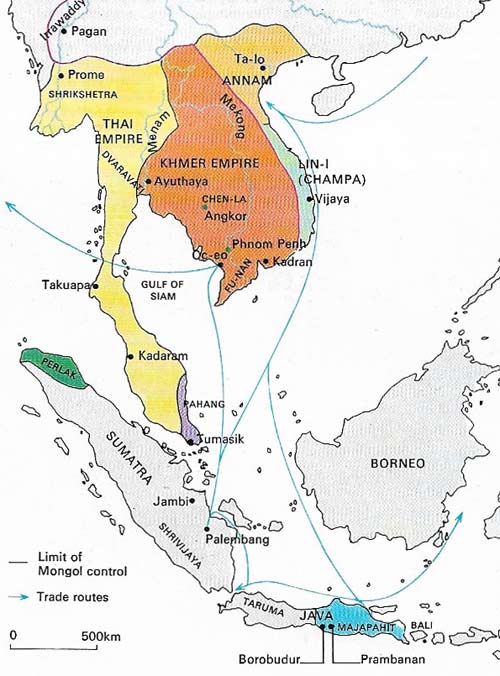
Figure 1. The geographic position of Southeast Asia, lying between India and China at the center of a monsoon system that facilitated sailing to and from both these countries, explain much of its cultural development and historical importance. The thriving commercial trade, carried inland along the great river systems, also brought a diversity of religious, political and cultural influences to the area.
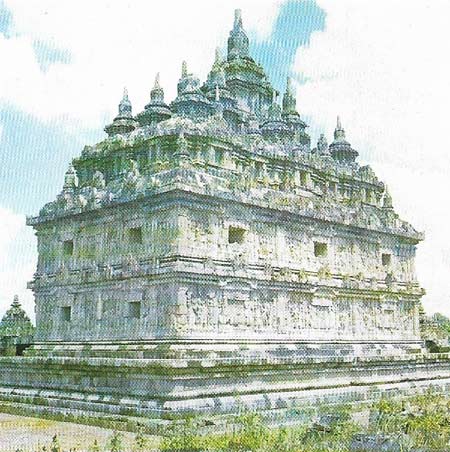
Figure 2. Chandi Plaosan in Central Java is the large Buddhist complex built in about mid-9th century. Two apparently symmetrical groups have central shrines framed by rectangles of temples. Each main building is two-storied and houses a pantheon of Buddhas and Bodhisattvas. Inscriptions say that the images "shine forth the Doctrine" and windows were evidently arranged to create a radiant effect.

Figure 3. Borobudur, one of the world's greatest Buddhist shrines, was built in about the middle of the 9th century to a unique plan involving colossal resources – 570,000 cubic meters (2 million cubic feet) of stone were moved from a river bed, dressed, positioned, and carved with countless spouts, urns and other embellishments. The walls are covered with reliefs relating to Buddhist doctrine and there are altogether 504 shrines with seated Buddhas.
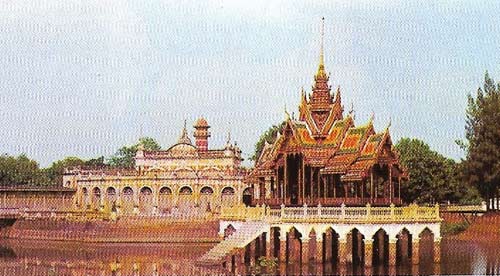
Figure 4. The Lake Pavilion at the Summer Palace, Bangkok, with its elaborate carving and gilding, is a reminder that bamboo and wood have been used as the materials for most buildings on Southeast Asia during the past millennium (as they still are today). Even shrines and their images were often wooden, so that much of the past has been lost from the archeological record.
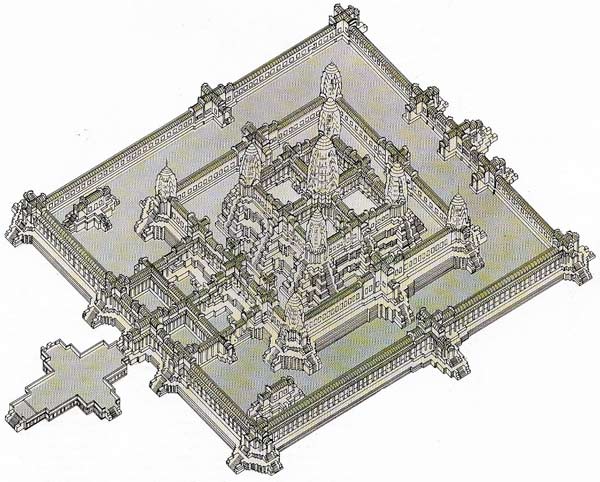
Figure 5. Angkor Wat, the creation of Suryavarman II (king of Cambodia c. 1113 to c. 1150), was the ritual center of his kingdom where the royal lingam (phallus), emblem of power, was housed. The outer cloister, 1,380 x 1,150 meters (4,529 x 3,733 feet), enclosed a complex of buildings, the main group arranged as a square of four at the corners and one in the center. All were covered in exquisite low relief with divine dancers, plants, birds and animals. The many towers housed images. The walls of the central group were covered with reliefs depicting Hindu stories and battle scenes. In two, the king was shown. It was to be his shrine after death when he became identified with the god Vishnu.
The lands that lie along the maritime route between the Indian subcontinent and China (Figure 1) have been strongly influenced by both of these regions. Except in Vietnam, the major cultural influence has been from India, but for most of the Christian era the kingdoms of Southeast Asia have recognized, to a greater or lesser degree, the ultimate political suzerainty of the emperors of China.
The first centuries AD
The involvement of India and China in the affairs of this complex region seems to have been the largely accidental result of a need to find an alternative route between them when the land journey was made difficult by political instability in central Asia. But the various parts of Southeast Asia had already achieved considerable technological, economic and political development by the time they came under the influence of their larger neighbors in the first centuries AD.
Lin-i, with its capital near Hue, and Fu-nan in the Mekong Delta, are two of the best known states that existed to the south of China in the early Christian era. Lin-i became the kingdom of Champa, which dominated central Vietnam and parts of the south until the 14th century. Funan grew into a substantial empire that dominated the greater part of the northern and eastern shores of the Gulf of Siam and their hinterland until the centre of power shifted, in about the middle of the 6th century, to a former vassal state, Chen-la, probably in the vicinity of the Tonle Sap. From this kingdom the Khmer Empire of Cambodia developed from the beginning of the ninth century onwards. To the west, in the 7th century, lay Dvaravati, near present-day Bangkok, and farther west again, in Burma, lay the Pyu kingdom of Shrikshetra, with its capital at Prome.
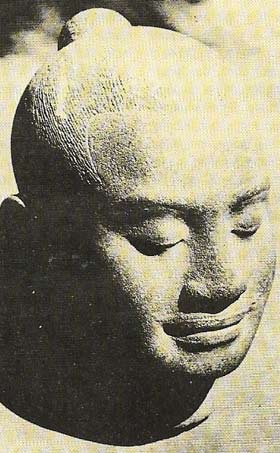 |
| Jayavarman VII (c. 1120–1215) became king of Cambodia in 1181 after driving out Cham invaders. Following his father, Suryavarman II, who built Angkor Wat, he embarked on an enormous building program. In addition to temples and associated buildings he created hospitals and rest-houses for travellers and improved roads, with many stone bridges still in use today. Most of his predecessors were Hindu, identifying themselves with Hindu gods; Jayavarman was a Buddhist who seems to have had a special relationship with the god Lokeshvara (shown here), whose carved head dominates the towers and gateways of his buildings. |
Southward in the Indonesian archipelago, and on the Malaysian peninsula (parts of which seem to have been dominated by Fu-nan), a number of small kingdoms flourished, due in part at least to the development of trading routes between China and the West. These routes brought Buddhist pilgrims through the region and traders whose posts seem to have attracted teachers of Hinduism as well. These religions, originating in India, became the state faiths of the king-doms of Southeast Asia, a role that Buddhism has retained, but Hinduism, except in Bali, has almost disappeared.
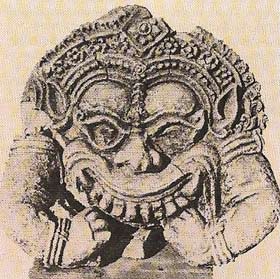 |
| A terracotta head from southern Thailand depicts a manifestation of Shiva's wrath – a creature that ate its own body to satisfy its hunger after the demon it was born to eat had been pardoned. |
 |
| Garuda, vehicle of the god Vishnu, was a magic bird and enemy of snakes. In Southeast Asia it became a divinity in its own right and was the center of salvationist cults of various kinds. |
Buddhist and Hindu influences
By about the 7th century AD a Chinese Buddhist traveller, I-ching, was advising his fellows to spend some time in Sumatra studying Sanskrit and Buddhism before going on to India. He himself spent almost a decade there translating Buddhist texts into Chinese. The rise of this center in western Indonesia, the beginnings of a state known as Shrivijaya which exercised commercial control in western Southeast Asia for several centuries, followed a shift of power from the coast to the interior on the mainland. Meanwhile, elsewhere in the archipelago, in west Java (Taruma) and Borneo, Indian influences began to be detectable and a major dynasty, the Shailendras, Lords of the Mountain, who may have had links with Fu-nan, came to power in central Java. There, from about the eighth to the 9th centuries, Buddhism (Figure 2) appears to have flourished, its culmination being seen in the shrine of Borobudur (Figure 3). This, with its miles of reliefs expounding the faith, is one of the world's greatest religious monuments.
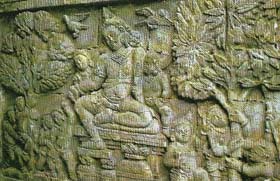 |
| Chandi Mendut, a small temple of the Borobudur group, probably served as an antechapel. This relief, on the north wall of the porch, shows Kuvera, god of wealth, often associated with the merchant class who supported Buddhism. |
Hinduism was not neglected, however, and it was perhaps from this setting that Jayavarman II (c. 770–850), "returning from Java" as an inscription says, established in Cambodia the kingdom that dominated the central mainland from about the 9th to the 14th centuries. Hinduism, centered upon a lingam (phallic) cult located in a temple at the center of the capital, was the state religion. The temples were of ever-increasing complexity, culminating in the magnificent structure of Angkor Wat (Fig 5) and the enigmatic Bayon in the centre of Angkor Thom. The economic strain of these ostentatious building programs possibly contributed to the fall of the Khmer Empire under attacks from both the Thai, newly established as a power to the west, and the Vietnamese on the eastern borders.
Eastern Java, also perhaps for socioeconomic reasons, saw the rise of the kingdom of Majapahit – a state whose maritime power enabled her to repel a Chinese fleet in 1293. Its influence extended as far west as central Sumatra and its blending of Hinduism and Buddhism was the culmination of a trend that can be detected in central Java as early as 782. The end of this kingdom seems to have been linked with the coming of Islam which, already established in northern Sumatra at the time of Marco Polo's visit in 1291, became important on the coast of Java a century or so later, although Majapahit's fall is usually dated to 1480.
Developments on the mainland
On the mainland, the Mongols, although unsuccessful in Java, had intervened with limited results in Vietnam. In Burma, the kingdom centred upon Pagan on the Irrawaddy, where some thousands of temples built over a period of two centuries testify to the power of Buddhism. It fell to the Mongols in 1287. At about the same time Rama Khamhaeng consolidated Thai power in what had been the western Khmer Empire to found the present state of Thailand.
